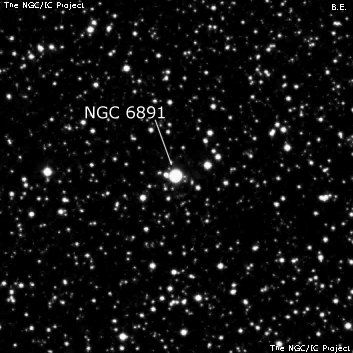NGC/IC Project Restoration Effort
(This is a very very beta version)
NGC6891


Basic Information
Location and Magnitude
Right Ascension: 20:15:8.9
Declination: +12:42:17
Constellation: DEL
Visual Magnitude: 10.5
Historic Information
Discoverer: Copeland
Year of discovery: 1884
Discovery aperture: 6.1
Observational
Summary description: planetary, stellar = 9.5 m
Sub-type: PN
Steve's Notes
=====
NGC 6891
24" (7/1/16): at 375x; very bright bluish disc slightly elongated NNW-SSE, perhaps 10"x8". A fainter outer halo increases the diameter to roughly 18". The mag 12.5-13 central star was steadily visible. A mag 14.5 star is close off the NE edge [17" from center]. At 750x the brighter inner disc seemed more elongated with tapered ends like a lens.
18" (9/10/07): Using 225x; the bright, blue disc of high surface brightness surrounds the central star. At 300x the very bright oval disc of 8"x6" diameter is surrounded by a fainter, round outer envelope that increases the diameter to ~15". With direct vision the central star is visible embedded in the center of the high surface brightness disc. A mag 12.5 star lies 1' WNW and a mag 13 star is a similar distance ESE with NGC 6891 nearly at the midpoint.
18" (7/15/07): at 174x this small blue disc has a high surface brightness and is very prominent in the field. With direct vision the mag 12.5-13 central star is easily visible. At 280x appears as a very bright, small disc with an unusually high surface brightness and the central star shines steadily. At 700x, the extremely bright inner region is slightly elongated or lens-shaped N-S and is surrounded by a fainter outer halo or envelope that is still quite evident.
17.5" (8/27/87): very bright at 140x and OIII filter. Appears as a small high surface brightness bluish oval of 10"-15" diameter. At 410x, a brighter center or mag 13 central star is visible. At this magnification, the planetary appears as a bright oval with a fainter outer halo.
8" (6/29/84): fairly high surface brightness, small blue disk.
80mm (9/10/07): visible as a faint "star" at 12.5x in the 80mm finder and easy to verify as a planetary by blinking with an OIII filter.



